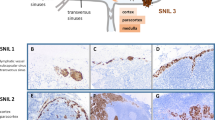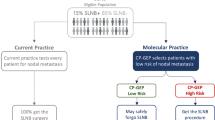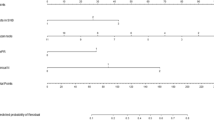Abstract
It is a basic tenet of the sentinel lymph-node biopsy procedure that all positive sentinel lymph nodes will inevitably progress to palpable nodal recurrence if not removed. Comparison of survival is, therefore, considered permissible among patients with positive sentinel lymph nodes who undergo early lymphadenectomy with that among patients who have delayed lymphadenectomy for palpable regional node metastasis, providing that survival is calculated from the date of wide local excision of the primary tumor. Here, that fundamental assumption is contested and evidence is presented to show that a positive sentinel lymph node might have no adverse prognostic relevance in up to one-third of patients. Furthermore, in the same patients, progression to palpable nodal disease might not have occurred even if the positive sentinel node had not been removed. The term prognostic false-positivity is used to describe this phenomenon. Such patients are incorrectly up-staged, are given inaccurate prognostic information and can undergo unnecessary completion lymphadenectomy and unnecessary adjuvant therapy.
Key Points
-
Prognostic false-positivity in the sentinel nodes of patients with melanoma is a reality
-
Such patients can be wrongly up-staged, might be given inaccurate prognostic information, and might undergo unnecessary lymphadenectomy and possibly unnecessary adjuvant therapy
-
A mathematical model suggests that the incidence of prognostic false-positivity in MSLT-1 is 24% for intermediate thickness tumors and 34% for all strata at the third interim analysis
-
Prognostic false-positivity has important implications for the management of patients with primary melanoma
This is a preview of subscription content, access via your institution
Access options
Subscribe to this journal
Receive 12 print issues and online access
$209.00 per year
only $17.42 per issue
Buy this article
- Purchase on Springer Link
- Instant access to full article PDF
Prices may be subject to local taxes which are calculated during checkout


Similar content being viewed by others
References
Kretschmer L et al. (2004) Patients with lymphatic metastasis of cutaneous melanoma benefit from lymphonodectomy and early excision of their nodal disease. Eur J Cancer 40: 212–218
Morton DL et al. (2003) Lymphatic mapping and sentinel lymphadenectomy for early-stage melanoma. Ann Surg 238: 538–550
Morton DL et al. (2005) Sentinel node biopsy for early-stage melanoma. Ann Surg 242: 302–311
Morton DL et al. (2006) Sentinel node biopsy or nodal observation in melanoma? N Engl J Med 355: 1307–1317
Balch CM and Cascinelli N (2006) Sentinel-node biopsy in melanoma. N Engl J Med 355: 1370–1371
Gershenwald JE and Ross IM (2007) Is sentinel-node biopsy superior to nodal observation in melanoma. Nat Clin Pract Oncol 4: 278–279
Thompson JF et al. (2007) Melanoma management in 2007. Aust Fam Physician 36: 487–488
Gershenwald JE et al. (1999) Multi-institutional melanoma lymphatic mapping experience: the prognostic value of sentinel lymph node status in 612 stage I or II melanoma patients. J Clin Oncol 17: 976–983
Kruper L (2005) Predicting sentinel lymph node status in stage I/II melanoma. J Clin Oncol 23: 710s
Bafounta M-L (2004) Ultrasound or palpation for detecting melanoma nodal invasion: a meta-analysis. Lancet Oncol 5: 673–680
Thompson JF and Shaw HM (2006) Benefits of sentinel node biopsy for melanoma. ANZ J Surg 76: 100–103
Balch CM (2001) Prognostic factor analysis of 17,600 melanoma patients. Validation of the American Joint Committee on Cancer Melanoma Staging System. J Clin Oncol 19: 3622–3634
Berk DR (2005) Sentinel lymph node biopsy for cutaneous melanoma: the Stanford experience, 1997-2004. Arch Dermatol 141: 1016–1022
Vuylsteke RJ (2003) Clinical outcome of Stage I/II melanoma patients after selective sentinel lymph node dissection: long-term follow-up results. J Clin Oncol 21: 1057–1065
Ranieri JM et al. (2002) Importance of lymph node tumour burden in melanoma patients staged by sentinel node biopsy. Ann Surg Oncol 9: 975–981
Carlson GW et al. (2003) The amount of metastatic melanoma in a sentinel lymph node. Does it have prognostic significance? Ann Surg Oncol 10: 575–581
Starz H et al. (2005) Sentinel lymphonodectomy and S-classification: a successful strategy for better prediction and improvement of outcome of melanoma. Ann Surg Oncol 11 (3 Suppl): 162S–168S
Spanknebel K et al. (2005) Characterisation of micrometastatic disease in melanoma sentinel lymph nodes by enhanced pathology: recommendations for standardizing pathological analysis. Am J Surg Pathol 29: 412–414
van Akkooi ACJ et al. (2006) Clinical relevance of melanoma micrometastases (<0.1 mm) in sentinel nodes: are these nodes to be considered negative? Ann Oncol 17: 1578–1585
Statius Muller MG et al. (2001) The sentinel lymph node status is an important factor for predicting clinical outcome in patients with Stage I or II cutaneous melanoma. Cancer 91: 2401–2408
Chao C et al. (2004) Correlation between prognostic factors and increasing age in melanoma. Ann Surg Oncol 11: 259–264
Carlson GW (2004) Age and the incidence of sentinel lymph node metastases in melanoma. Ann Surg Oncol 11: 236–237
Giblin A-V and Thomas JM (2007) Incidence, mortality and survival in cutaneous melanoma. J Plast Reconstr Aesthet Surg 60: 32–40
Sondak VK et al. (2004) Mitotic rate and younger age are predictors of sentinel lymph node positivity: lessons learned from the generation of a probabilistic mode. Ann Surg Oncol 11: 247–258
Thompson JF and Shaw HM (2004) Should tumour mitotic rate and patient age, as well as tumour thickness, be used to select melanoma patients for sentinel node biopsy? Ann Surg Oncol 11: 233–235
Morton DL et al. (2007) Sentinel node biopsy in melanoma. N Engl J Med 356: 419–421
Fidler IJ and Ellis LM (1994) The implications of angiogenesis to the biology and treatment of cancer metastasis. Cell 79: 185–188
Barnhill RL (2001) The biology of melanoma micrometastases. Recent Results Cancer Res 158: 3–13
Malafa MP et al. (2002) Inhibition of angiogenesis and promotion of melanoma dormancy by vitamin E succinate. Ann Surg Oncol 9: 1023–1032
Gerdes J et al. (1984) Cell cycle analysis of a cell proliferation-associated human nuclear antigen defined by the monoclonal antibody Ki-67. J Immunol 133: 1710–1715
Pearl RA et al. (2007) Ki-67 expression in melanoma. A potential method for risk assessment for patients with positive sentinel nodes. J Exp Clin Cancer Res 26: 109–115
Abrahamsen H (2004) Sentinel lymph nodes in melanoma. Extended histopathological evaluation improves diagnostic precision. Cancer 100: 1683–1691
Author information
Authors and Affiliations
Ethics declarations
Competing interests
The author declares no competing financial interests.
Rights and permissions
About this article
Cite this article
Thomas, J. Prognostic false-positivity of the sentinel node in melanoma. Nat Rev Clin Oncol 5, 18–23 (2008). https://doi.org/10.1038/ncponc1014
Received:
Accepted:
Issue Date:
DOI: https://doi.org/10.1038/ncponc1014
This article is cited by
-
Sentinel lymph node excision with or without preoperative hybrid single-photon emission computed tomography/computed tomography (SPECT/CT) in melanoma: study protocol for a multicentric randomized controlled trial
Trials (2019)
-
Surgery for Metastatic Melanoma: an Evolving Concept
Current Oncology Reports (2019)
-
A review of sentinel lymph node biopsy for thin melanoma
Irish Journal of Medical Science (1971 -) (2015)
-
MSLT-1—SNB is a biomarker, not a therapeutic intervention
Nature Reviews Clinical Oncology (2014)
-
MSLT-1—putting sentinel lymph node biopsy into context
Nature Reviews Clinical Oncology (2014)



